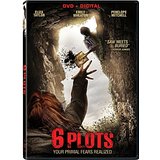The continent of Australia has seen a small renaissance of horror films over the last fifteen years. Considering the continent’s rich history with suspenseful cinema, the frequency of these films is indeed exciting. Picnic at Hanging Rock and The Chant of Jimmy Blacksmith are two movies that have stuck with me over the years, considering I only watched each title once. I remember the suspense and terror created in the atmosphere of Picnic, through a combination of a simple plot of a missing child and an ominous score. Jimmy Blacksmith’s climax is one of the most psychologically tormenting experiences I have had watching a film. That was the 70’s. In recent years, Australia has released some great horror genre gems that really do a great job of tracing their roots back to the aforementioned films. Wolf Creek, Feed, and The Horseman are some of the Australian horror titles that really have gotten my attention since the early 2000’s. Unfortunately, for every gem in Australian horror, there are over a dozen rocks you must sift through, and 6 Plots is one of those rocks.
The plot description sounds promising: After passing out at a party, the least popular girl in the “popular clique” wakes up to find she and her friends have been kidnapped. As the night progresses, she is able to contact her friends via their cell phones, and she learns that each of her friends have been placed inside boxes located across the small town. The killer allows the cell phones for communication amongst the group, but warns them not to involve parents or authorities. Rules are broken, some horrifying images follow, and realistically, nothing happens that I have not seen before.
6 Plots falls in line with modern (post Scream) teen slasher flicks. The issue here is that it tries to incorporate a few criticisms of the tech-savvy youth in Australia, but only superficially. At first, it seems as if the teens are being murdered because they rely on cell phones to be social creatures, but as body count rises, that ethical dilemma diminishes. The reason for cell phones being in the boxes is solely for communication. Basically, I am confused about the actual message regarding technological dependence. All the friends are connected via cell phone, the killer is connected to the victims via cell phone and streams their captivity (and deaths) onto the internet, and of course, students from the high school are connected by watching the live streams of murder. It is very easy to see all the interconnectivity, and therefore, very easy to raise questions of who is actually implicated in the murders if everyone is watching. What is difficult to understand amidst all of this is why any of it actually matters.
Technically, the film was originally released regionally in 2012, and I am only now receiving it as an international release. With that said, I know that in the United States, the technological climate among young adults has changed tremendously within four short years. If anything, technological dependence has become more extreme than it is depicted the film. So what is the film actually trying to tell us? That if we use our technologies to witness a murder and do nothing about it, we are implicated in said crime? Using technology to witness murder is an arguable definition of horror cinema (fictional though it may be). Like all horror cinema, 6 Plots fetishizes death. However, I feel that there may have been something lost in translation from script to screen, because it has all right the ingredients for technological criticism; it just got so excited about the disgusting imagery that it left out the crucial ingredients to provide full stimulus.
The film’s only saving grace is the way in which the killer communicates to all the victims. It is via cell phone, but through a rather creepy animated emoticon. It is basically a smiley face with bulging eyes with a human-like jaw affixed to it, giving it the illusion of actually speaking. Basically, a digital puppet. That, in and of itself, was pretty fun to watch. However, instead of letting it be its own creepy entity, the face was unnecessarily tied back to the killer towards the end, and then we are given the killer’s motives in a 10-second flashback. This flashback is the very last part of the film, and did not serve the plot in any way. I would have rather the killer remain anonymous than a hasty explanation as to why someone might want to kill a group of pretentious young people.
Going back to my “gem among the rocks” analogy, I have seen quite a few terrible Australian horror films. A trend that I do notice is that these films start at a very slow pace (approximately 25 minutes to introduce characters and develop story), and the stories we are given just don’t generate interest within me. By the time I get to the new ways a film will be fetishizing death, I am already a little too bored to sit through it. 6 Plots will satisfy your desire for blood and gore, but it does not satisfy your curiosity as to why the story takes place.



